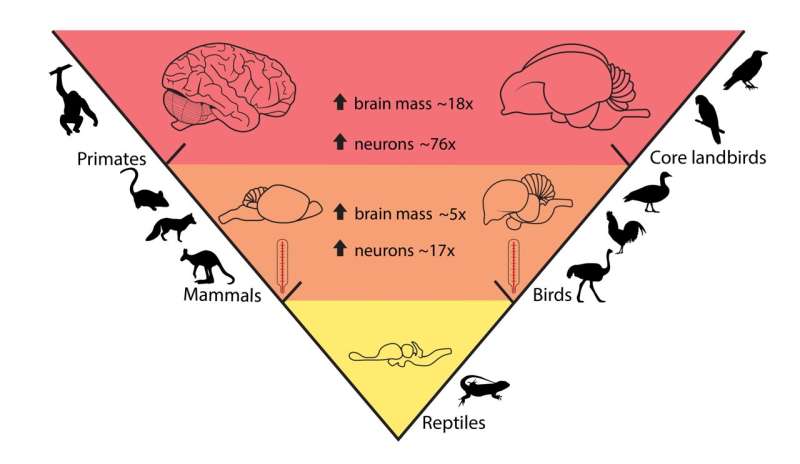Neuron counts reveal brain complexity evolution in land vertebrates

Researchers from the Charles University in Prague reconstructed the evolution of brain neuron numbers in amniotes and revealed that mammals and birds have dramatically increased neuron numbers in brain parts associated with higher cognition. These findings suggest that as few as four major changes in neuron-brain scaling in over 300 million years of evolution pave the way to avian and mammalian intelligence.
The evolution of brain processing capacity has traditionally been inferred from data on brain size. However, similarly sized brains of distantly related species can differ in the number and distribution of neurons, their basic computational units. Therefore, we need to compare brains not by mass but by numbers of neurons to reveal the evolutionary paths to increased cognitive capacity.
Using a new, comprehensive dataset, researchers now analyzed brain cellular composition across amniotes. Compared to reptiles, mammals and birds have dramatically increased neuron numbers in the telencephalon and cerebellum, which are brain parts associated with higher cognition. Astoundingly, a phylogenetic analysis suggests that as few as four major changes in neuron–brain scaling in over 300 million years of evolution pave the way to intelligence in endothermic land vertebrates.
"Using the largest dataset of its kind and including essential data on reptiles, our study reconstructs the evolution of brains across amniotes by directly analyzing neuron numbers. The results suggest that a handful of unique evolutionary events augmented brain processing power in birds and mammals. Therefore, it does not come as surprise that high intelligence is a rare capacity," says one of the authors of the study Pavel Němec from Department of Zoology, Faculty of Science at Charles University.
The research shows that reptiles have not only small brains relative to body size but also low neuronal densities, resulting in average neuron numbers over 20 times lower than those in birds and mammals of similar body size. Amniote brain evolution is characterized by the following four major shifts in neuron–brain scaling.
The most dramatic increases in brain neurons occurred independently with the appearance of birds and mammals, resulting in convergent neuron scaling in the two endotherm lineages. It seems that endothermy, an energetically expensive mode of life, enabled this remarkable gain of metabolically costly neurons. This highlights energetic constraints as a crucial factor in brain evolution. The other two major increases in the number of neurons happened in core land birds and anthropoid primates, which are two groups known for their cognitive prowess.
Interestingly, "relative brain size is associated with relative neuronal cell density in reptiles, birds, and primates but not in other mammals. This has important implications for studies using relative brain size as a proxy when looking for evolutionary drivers of animal cognition." says another member of the research team, Kristina Kverková from the Department of Zoology, Faculty of Science at Charles University.
More information: The evolution of brain neuron numbers in amniotes, PNAS (2022). DOI: 10.1073/pnas.2121624119
Journal information: Proceedings of the National Academy of Sciences
Provided by Charles University


















